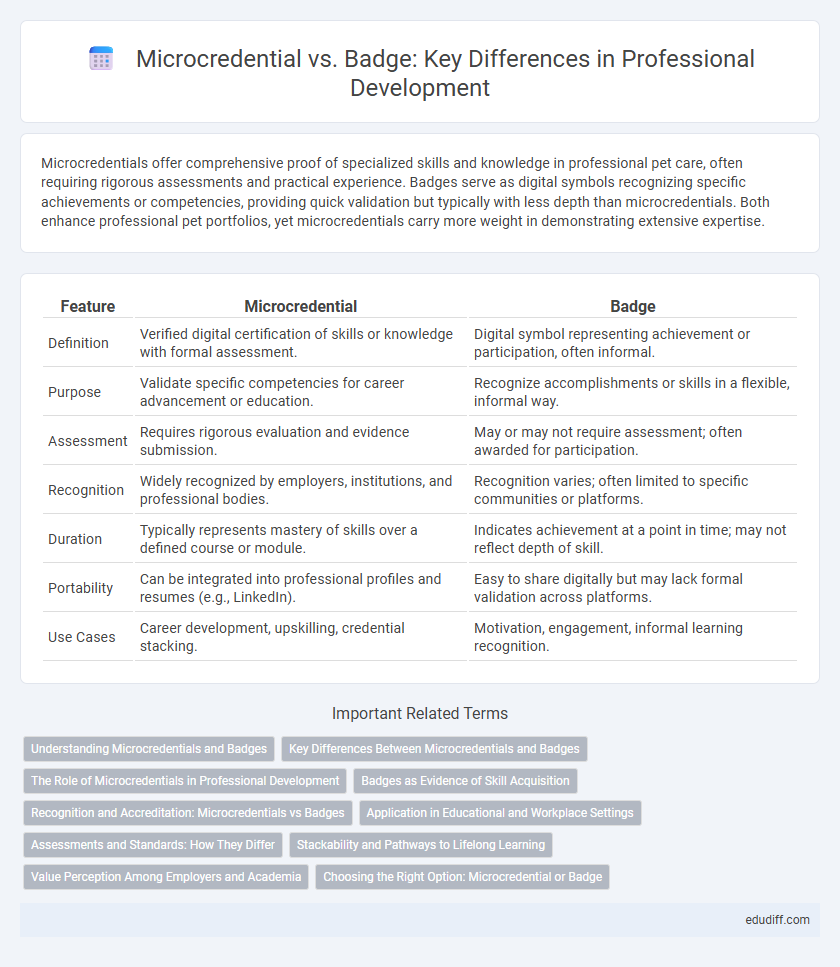Microcredentials offer comprehensive proof of specialized skills and knowledge in professional pet care, often requiring rigorous assessments and practical experience. Badges serve as digital symbols recognizing specific achievements or competencies, providing quick validation but typically with less depth than microcredentials. Both enhance professional pet portfolios, yet microcredentials carry more weight in demonstrating extensive expertise.
Table of Comparison
| Feature | Microcredential | Badge |
|---|---|---|
| Definition | Verified digital certification of skills or knowledge with formal assessment. | Digital symbol representing achievement or participation, often informal. |
| Purpose | Validate specific competencies for career advancement or education. | Recognize accomplishments or skills in a flexible, informal way. |
| Assessment | Requires rigorous evaluation and evidence submission. | May or may not require assessment; often awarded for participation. |
| Recognition | Widely recognized by employers, institutions, and professional bodies. | Recognition varies; often limited to specific communities or platforms. |
| Duration | Typically represents mastery of skills over a defined course or module. | Indicates achievement at a point in time; may not reflect depth of skill. |
| Portability | Can be integrated into professional profiles and resumes (e.g., LinkedIn). | Easy to share digitally but may lack formal validation across platforms. |
| Use Cases | Career development, upskilling, credential stacking. | Motivation, engagement, informal learning recognition. |
Understanding Microcredentials and Badges
Microcredentials are formal, competency-based certifications that validate specific skills or knowledge acquired through structured learning programs, often recognized by academic institutions or professional bodies. Badges serve as digital representations of achievements or skills, typically awarded for completing short-term tasks or activities and are easily shareable on professional networks. Both microcredentials and badges enhance employability by showcasing verified expertise, but microcredentials generally hold greater weight due to their rigorous assessment criteria and formal recognition.
Key Differences Between Microcredentials and Badges
Microcredentials represent comprehensive, often accredited certifications demonstrating mastery of specific skills or competencies, typically backed by educational institutions or industry bodies. Badges function as digital tokens recognizing short-term achievements, skills, or participation, offering more flexibility but less formal validation. The key difference lies in microcredentials' depth and formal recognition versus badges' focus on quick, verifiable skills acknowledgment within professional development ecosystems.
The Role of Microcredentials in Professional Development
Microcredentials play a crucial role in professional development by offering targeted, verifiable skill validation that aligns with industry standards and evolving job requirements. Unlike badges, which often serve as informal recognition of participation or completion, microcredentials provide comprehensive assessments and credentials that enhance career advancement and employer trust. The integration of microcredentials into professional learning pathways facilitates continuous skill enhancement and supports lifelong learning strategies.
Badges as Evidence of Skill Acquisition
Badges serve as verifiable digital credentials that demonstrate specific skill acquisition, offering learners a portable and easily shareable record of competencies. Unlike traditional microcredentials, badges often provide granular evidence of mastery in niche areas through metadata that details criteria and assessment methods. This transparency enhances employer trust by validating skill attainment and supporting professional development pathways.
Recognition and Accreditation: Microcredentials vs Badges
Microcredentials offer formal recognition and accreditation from educational institutions or industry bodies, often involving rigorous assessment and detailed competency verification. Badges provide a more informal acknowledgment of specific skills or achievements, usually without standardized accreditation or extensive validation processes. The distinction lies in microcredentials' ability to contribute to official qualifications, whereas badges primarily serve as digital symbols of skill acquisition.
Application in Educational and Workplace Settings
Microcredentials validate specific skills and competencies through comprehensive assessments, making them highly applicable for formal education and professional development programs. Digital badges serve as portable visual representations of achievements, facilitating easy sharing on professional networks and enhancing informal learning recognition. Both tools support lifelong learning by aligning skill verification with industry standards and career advancement opportunities.
Assessments and Standards: How They Differ
Microcredentials involve rigorous assessments aligned with industry standards, requiring demonstration of specific competencies through project-based assignments or exams. Badges typically reflect the completion of shorter, less formal learning activities and may lack standardized assessment criteria, focusing more on participation or skill recognition. The key distinction lies in microcredentials adhering to validated benchmarks ensuring verifiable expertise, whereas badges often serve as informal acknowledgments without consistent evaluation protocols.
Stackability and Pathways to Lifelong Learning
Microcredentials offer stackability by allowing learners to accumulate smaller, focused units of learning that build toward comprehensive qualifications, creating clear pathways to lifelong learning. Badges serve as digital symbols recognizing specific skills or achievements but often lack the structured progression system intrinsic to microcredentials. The integration of microcredentials into educational and professional development frameworks enhances personalized learning journeys and continuous skill advancement.
Value Perception Among Employers and Academia
Microcredentials provide comprehensive proof of skills and competencies, often aligning with academic standards and industry requirements, making them highly valued by employers and educational institutions. Badges serve as digital symbols of achievement but may lack the detailed verification and depth associated with microcredentials, resulting in varied recognition levels. Employers and academia increasingly prioritize microcredentials for their robust validation and relevance to career advancement and lifelong learning.
Choosing the Right Option: Microcredential or Badge
Choosing between a microcredential and a badge depends on career goals and skill validation needs. Microcredentials provide comprehensive proof of mastery with formal assessments and often carry more weight in professional and academic circles. Badges offer flexible, easily shareable recognition for specific skills or achievements but may lack the depth and credibility of microcredentials.
Microcredential vs Badge Infographic

 edudiff.com
edudiff.com